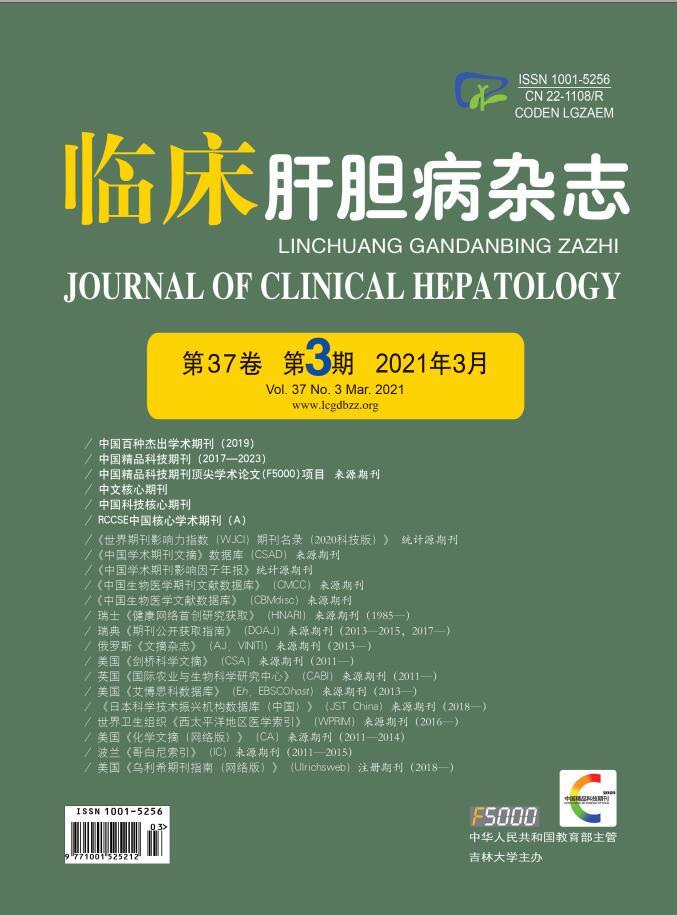| [1] |
Drug-induced Liver Disease Study Group, Chinese Society of Hepatology, Chinese Medical Association. Guidelines for the management of drug-induced liver injury[J]. J Clin Hepatol, 2015, 31(11): 1752-1769. (in Chinese) DOI: 10.3969/j.issn.1001-5256.2015.11.002 |
| [2] |
SHEN T, LIU Y, SHANG J, et al. Incidence and etiology of drug-induced liver injury in Mainland China[J]. Gastroenterology, 2019, 156(8): 2230-2241. e11. DOI: 10.1053/j.gastro.2019.02.002 |
| [3] |
ROBLES-DIAZ M, LUCENA MI, KAPLOWITZ N, et al. Use of Hy's law and a new composite algorithm to predict acute liver failure in patients with drug-induced liver injury[J]. Gastroenterology, 2014, 147(1): 109-118. e5. DOI: 10.1053/j.gastro.2014.03.050 |
| [4] |
SGRO C, CLINARD F, OUAZIR K, et al. Incidence of drug-induced hepatic injuries: A French population-based study[J]. Hepatology, 2002, 36(2): 451-455. DOI: 10.1053/jhep.2002.34857 |
| [5] |
SUK KT, KIM DJ, KIM CH, et al. A prospective nationwide study of drug-induced liver injury in Korea[J]. Am J Gastroenterol, 2012, 107(9): 1380-1387. DOI: 10.1038/ajg.2012.138 |
| [6] |
BJÖRNSSON ES, BERGMANN OM, BJÖRNSSON HK, et al. Incidence, presentation, and outcomes in patients with drug-induced liver injury in the general population of Iceland[J]. Gastroenterology, 2013, 144(7): 1419-1425, 1425. e1-e3; quiz e19-e20. DOI: 10.1053/j.gastro.2013.02.006 |
| [7] |
HE TT, JING J, BAI ZF, et al. Constituent ratio and changing trend of non-infectious liver diseases in the fifith Medical Center of Chinese PLA General Hospital from 2002 to 2018[J]. J Clin Hepatol, 2020, 36(8): 1773-1777. (in Chinese) DOI: 10.3969/j.issn.1001-5256.2020.08.019 |
| [8] |
LUCENA MI, ANDRADE RJ, KAPLOWITZ N, et al. Phenotypic characterization of idiosyncratic drug-induced liver injury: The influence of age and sex[J]. Hepatology, 2009, 49(6): 2001-2009. DOI: 10.1002/hep.22895 |
| [9] |
AMACHER DE. Female gender as a susceptibility factor for drug-induced liver injury[J]. Hum Exp Toxicol, 2014, 33(9): 928-939. DOI: 10.1177/0960327113512860 |
| [10] |
|
| [11] |
CHALASANI N, BONKOVSKY HL, FONTANA R, et al. Features and outcomes of 899 patients with drug-induced liver injury: The DILIN prospective study[J]. Gastroenterology, 2015, 148(7): 1340-1352. DOI: 10.1053/j.gastro.2015.03.006 |
| [12] |
TESCHKE R. Top-ranking drugs out of 3312 drug-induced liver injury cases evaluated by the Roussel Uclaf Causality Assessment Method[J]. Expert Opin Drug Metab Toxicol, 2018, 14(11): 1169-1187.
|
| [13] |
JIN XL, YANG ZB, ZHAN SH, et al. Influencing factor of liver dysfunction of inpatients of tuberculosis with initial treatment[J/CD]. Chin J Exp Clin Infect Dis (Electronic Edition), 2020, 14(5): 394-400. (in Chinese)
金小琳, 杨智彬, 詹淑华, 等. 1501例初治住院结核病患者肝功能异常的影响因素[J/CD]. 中华实验和临床感染病杂志(电子版), 2020, 14(5): 394-400.
|
| [14] |
ANDRADE RJ, LUCENA MI, FERNÁNDEZ MC, et al. Drug-induced liver injury: An analysis of 461 incidences submitted to the Spanish registry over a 10-year period[J]. Gastroenterology, 2005, 129(2): 512-521. DOI: 10.1016/j.gastro.2005.05.006 |
| [15] |
ALHADDAD O, ELSABAAWY M, ABDELSAMEEA E, et al. Presentations, causes and outcomes of drug-induced liver injury in Egypt[J]. Sci Rep, 2020, 10(1): 5124. DOI: 10.1038/s41598-020-61872-9 |







 DownLoad:
DownLoad: